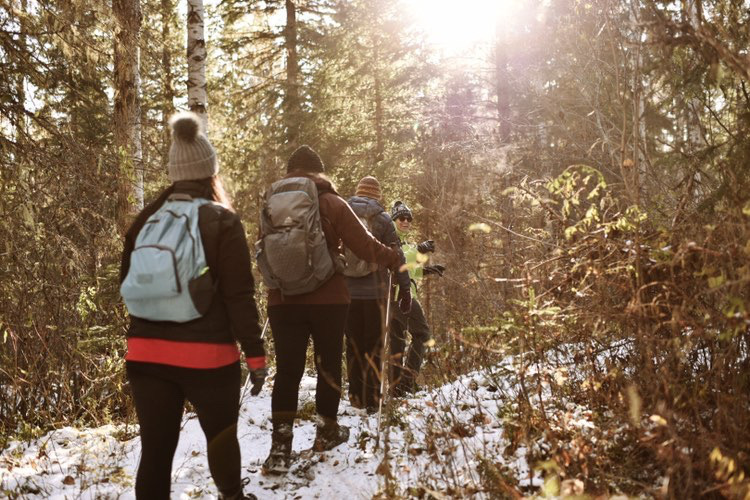Many hikers have heard that they should bring “the ten essentials” with them on every hike. Who came up with the list? Do we really have to bring them all?
The original list was developed in the 1930’s by The Mountaineers, a Seattle based outdoor group. The goal was to ensure adventurers had enough equipment to avoid trouble on the trail; and then deal with trouble if it does eventually find them. It was a great list at the time, and even today it holds solid wisdom about what to bring.
Let’s explore what each of the ten essentials are, and how they can be adapted to suit modern hikers.
1. Navigation 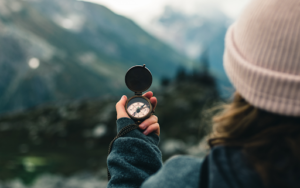
Map & Compass
Old school navigation tools still have an important place in today’s hiking pack. We can sometimes get too used to our devices telling us exactly where we are all the time, and lose our sense of direction. The basics of map & compass navigation can be learned in less than a day, but can really help you get lost less often and get yourself found faster.
The solid understanding of navigation skills you get from using a map will also make using digital tools much easier and less prone to errors.
Phone
Modern smartphones have impressively accurate location technology, and there are a huge number of navigation apps. Gaia GPS and Alltrails are well known apps that have a lot of good info and features.
One important thing to know when using hiking navigation apps: the hiking trail info is usually crowdsourced from other users. Just like following someone else’s footprints on the trail, be sure to use your own judgment and don’t just follow others blindly.
Apps like All Trails are great when selecting and planning a hike, but shouldn’t be your only navigation means.
GPS (Global Positioning Satellite)
These devices will be more rugged, have longer battery life, and often a stronger connection to satellites. If you will be doing a lot of continuous navigation through bad weather and rough terrain, an upgrade from a smartphone app to a GPS unit may be in order.
2. Communication
Trip Plan
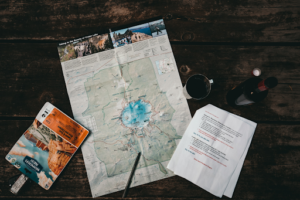
This is the most important communication tool for any hiker. The awesome part is that it is free, easy, and incredibly useful in an emergency. Whenever you are heading out on an adventure, leave a trip plan with a trusted person.
These can be as simple or complex as you want to make them, but any trip plan should include:
- What trailhead you will be parked at, and what car you drive
- Who you are with (including their contact info)
- Where you plan to hike (including your plan B)
- When you expect to return (and how long after that help should be called if you don’t return on time)
- What experience and equipment you have with you
- Who they should call if you don’t return
- This will most often be the local RCMP
- Some National Parks have dedicated search and rescue team
I keep a blank template in my email folder, and it usually takes less than 3 minutes to put together an email to a friend (less than half the time I spend on the instagram post afterwards!)
Phones
Phones can be a great resource, as long as you have enough service to use one. If you are on the edge of service, try these tricks:
Call 911: In Canada a 911 call may get through when regular calls can’t. Phone companies normally only operate on their own network of cell towers, but if you dial 911 you can use ANY network. Only use this option if it’s a real emergency, and not if you’re just going to be an hour late for dinner.
Satellite Devices
There are many devices that operate off satellite networks with global coverage, and allow you to send your location and messages, and most will also have GPS navigation. Look for ones with two way communication and non-emergency communication.
When you hit the SOS button, your location is sent to a dispatch center. With two way communication, you can give extra info to help speed up your rescue such as, “We are a group of 3 with one broken ankle on the located 1 km south of Raven Lake, within Sugar-bowl grizzly Den Provincial Park. We will wait here for help.” The best part of having two way communication is receiving a message back saying, “Message received, help is on the way”. Getting that message back may be the most relieving thing you ever hear.
Non-emergency communication lets you send messages home like, “I am going to be late, but am ok and making my way to the car, no help needed. Please save me some pizza”.
3. Food & Water
Bring enough food for your planned trip, plus a little bit extra. One of the fastest ways to make friends in the backcountry is to have spare snacks to share when everyone else has eaten theirs. For a daytrip, bring along a few extra bars. For overnights, bring along one extra lightweight dinner; even a simple pack of ramen will seem downright delectable if you end up spending an extra night out. If you are out longer than planned, extra snacks make it feel more like a bonus adventure than a death march.
Bringing a little extra water is always a good idea, even for the most weight conscious person. You can always dump some out on the trail if it becomes clear you don’t need it, but water can be tricky to find on some hikes. Water filters also allow you to refill on the go, and don’t weigh much. I have been on a few hikes where we ran out of water, and let me tell you; I was sad.
4. Sun Protection
The sun can drain us of energy, often without us even know it’s happening. Sunburn and heat exhaustion can quickly turn a fun hike into an uncomfortable situation, or even an emergency. We are most aware of this during summer, but the sun can also burn and dehydrate us on cool windy days and even in winter.
Sunglasses, sunhat, sunscreen and lightweight long sleeve shirts are the best tools to protect ourselves from the sun.
If you want to work on your tan, save it for your backyard or at the beach.
5. Light
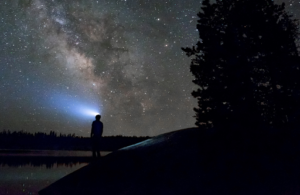
No matter how long you plan to be out, it’s worthwhile have a light source with you (And no, the flashlight feature on your phone doesn’t count!)
A light can make you highly visible to potential rescuers, and can help you avoid getting lost if the last part of your hike takes part after sunset. Modern LED headlamps are lightweight, powerful, and the batteries can last for days.
The one exception to this rule is if you are adventuring in the summer in the arctic when they have sunlight 24 hours a day. That’s it. Bring a light every other time.
6. Repair Kit / Tools
Stuff breaks. It breaks all the time, and rarely when it is convenient. If we embrace our inner MacGyvers, we can field repair most items. It won’t always be pretty, but it can be enough to make things functional again for the rest of the hike.
For simple day hikes, a repair kit might include:
- Spare shoelaces
- Pocket knife or multitool
- Spare hip belt buckle
- Tape
- A few zip ties
- 1-2 Ski Straps
For multi-day trips, we can add on:
- Tent pole repair kit
- Sleeping pad repair kit
- Needle & thread
7. Fire Starter
If you end up having to spend a night out or wait in one place for a long time, building a fire will make the experience so much better. Starting a fire by rubbing sticks together only works in the movies or if you are a survival expert, so save yourself the hassle and bring along a lighter or some waterproof matches.
If you hike in rainy places where starting a fire will be extra hard, bring along some starting materials. My favourite is dryer lint stuffed into a cardboard egg carton with candle wax melted on top. They are cheap, easy, and can make even the worst fire maker look like a wizard.
8. Clothing
Dressing in layers helps ensure you have the right clothing for the right moments, and you can change to accommodate different
For dayhikes, bring enough clothing that you could spend a night out if you had to. Probably a very chilly and uncomfortable night, but where you keep all your fingers and toes.
For multi-day trips, this means bringing enough so that you will be ready to face the worst the weather forecast has to offer, plus a little extra.
9. Emergency Shelter
This usually takes the form of a tarp. This can range from a simple foil emergency blanket 2 people can huddle under all the way up to a large siltarp a group of 6 can sleep under.
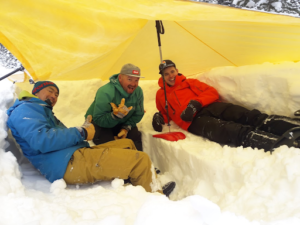
10.First Aid Kit
This includes the training beforehand to know how to use the stuff inside your first aid kit. Wilderness first aid courses are offered most places, and are well worth the time and effort.
A basic first aid kit will have blister treatment, bandages, tensor, splinting material, and
The bigger the hike and more remote your adventure will be, the bigger your first aid kit will be. Scale it
Share & Scale
Everyone on a hike doesn’t need to bring all 10 essentials. As long as the overall team has them covered, you are set. The first aid kit, shelter, fire starter, repair kit, navigation, and communication are all items that you may only need one or two of for the whole group.
This list can seem like a lot, but it soon becomes second nature to pack for an adventure with these in mind. Scale what you pack to the size of your trip. The repair kit you need for a 3 hour summer stroll will be very different from the one you need for a multi-day snowshoe trip.
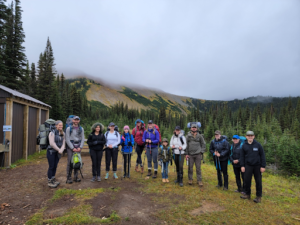
Now that you are fully prepared, go forth and adventure!
Article written by Susan Twitchell – ACMG Apprentice Hiking guide

